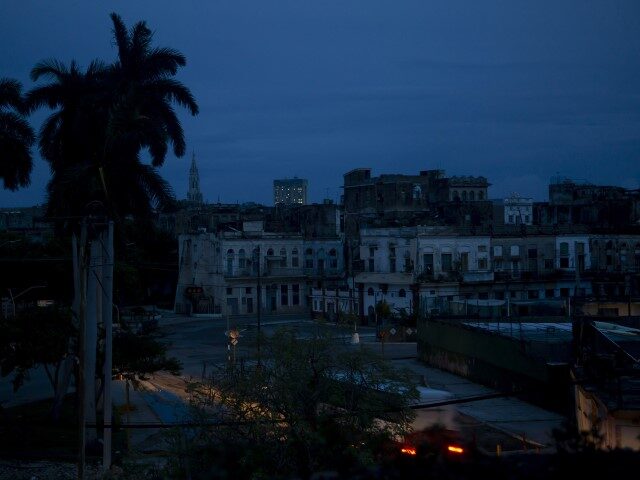Cuba’s Electrical Union (UNE), the state power company, confirmed on Tuesday night that the entire island had lost power as Hurricane Ian passed through, announcing “zero electric generation” on the part of any of its infrastructure.
Cuba, once Latin America’s wealthiest nation, is now among its poorest thanks to over half a century of communism. Blackouts have become common occurrences throughout the island – though only where Cubans reside, not in the Castro’s regimes luxury hotels and tourist destinations – and prompted waves of increasingly populous and unruly protests. Cubans staged an average of 11 protests a day in August, many of them denouncing unnecessary blackouts caused by the regime failing to maintain electricity infrastructure or answer to reports of downed power lines or other situations needing repair.
Rather than responding to the complaints, the Communist Party has largely addressed the protests by sending its repressive forces to beat and imprison civilians demanding basic government services. In one particularly notorious incident last month, Cuban police forces physically beat three girls between ages 11 and 12 for attempting to protect their father from an arrest during a protest against blackouts in eastern Camagüey province. Police then arrested the mother of one of the girls for denouncing the abuse on social media.
Reports from Cuba’s westernmost province Pinar del Río on Wednesday indicated that Hurricane Ian had caused mass devastation, leaving many homeless and rendering blocks of buildings uninhabitable. At press time, government officials have confirmed two deaths.
“The [National Electric System] SEN with 0 electric generation (without electric service in the country), condition associated with climate effects,” the government power service confirmed on Tuesday night, stating that the damage in power infrastructure would begin “gradually” to be addressed through Wednesday night.
The Communist Party’s official newspaper, Granma, confirmed that the government’s electric grid failed in its entirety on Tuesday night.
“The failure occurred in the eastern, central, and western links,” the newspaper explained, “a complex process that, to reestablish it [service], will require work with precision throughout the night on Tuesday and through midnight Wednesday.”
Granma repeatedly warned Cubans that the restoration of service “will take time.”
Satellite images of the island on Tuesday night showed the vast majority of the island without power with the exception of tourist areas in Havana and the northern peninsula where Varadero, a luxury beach destination, is located. Given the UNE announcement, the visible lights are likely being produced by independent generators.
By Wednesday, Cuban communist authorities indicated that some electricity had returned to Oriente, the easternmost province and least affected by the hurricane. Conversely, the worst of the damage appears to have occurred in westernmost Pinar del Río, where authorities warned it would take as long as a week for any electric service to return anywhere in the province. The Spain-based Diario de Cuba publication, citing sources on the island, reported that major tobacco farms, small businesses, and residences have been devastated.
“I know people who lost their entire houses, they are totally destroyed,” Yaily Rodríguez Valdés, a Pinar del Río resident, told Diario de Cuba. “We can see here all the trees fallen. The transformer in front of my house fell. The telephone lines don’t work. We have no power.”
Speaking to the independent Cuban outlet 14 y Medio, other residents described Pinar del Río as “a total disaster area.” Luis González, a tobacco farmer, only managed half an interview with the outlet before the connection dropped in which he described “extensive” agricultural damage. Tobacco is one of the communist regime’s most lucrative goods.
Pinar del Río is one of Cuba’s largest agricultural producers; 14 y Medio noted that locals expect entire crop harvests to be destroyed.
Prior to the hurricane’s landing, residents had already begun to complain that the government had not adequately prepared, leaving many families without food and potable water despite dire meteorological predictions for the province.
“We haven’t been able to find a bar of guava jelly, or some crackers,” one resident told 14 y Medio. “There are people in my neighborhood who have not even been able to amass water because we haven’t had a supply for days.”
The outlet noted that even stores in the region catering to wealthy communist elites requiring “convertible” currency were empty shortly before the storm.
Havana, an urban center that suffered less severe damage than Pinar del Río, still appeared devastated by the hurricane. Images shared by social media users on the island appeared to show much of Havana’s vulnerable architecture collapsing, blocking entire streets with rubble. Havana regularly endures building collapses, including of major tourist attractions and hotels.
The pages of Granma on Wednesday morning were full of communist propaganda, encouraging Cubans to overcome the natural disaster with ideology.
Even with all its Category 3 hurricane pedigree, it [Ian] chose the wrong path to do damage,” one propaganda article bizarrely proclaimed. “It got itself tangled in the most potent hurricane of solidarity known in these latitudes.”
Granma reminded readers that, amid the natural disaster, September 28 was “Committees for the Defense of the Revolution Day,” a communist holiday to honor the regime’s neighborhood espionage system.

COMMENTS
Please let us know if you're having issues with commenting.